
You’ve had an issue with a client. You’re both feeling annoyed and frustrated, and you may also feel unsure how to move forward. This could have been down to a simple miscommunication, or an error in a service you delivered to them. You might feel like tearing your hair out because what you’re saying isn’t getting through to them. It can be hard to see past what’s happening at this moment in time and see anything positive.
“Your most unhappy customers are your greatest source of learning.” – Bill Gates
From personal experience and my career thus far, I find this quote to be absolutely true. If problems don’t ever arise, how are you supposed to learn and evolve? This is such a crucial concept, especially when it comes to customer experience. It can feel like a pit in your stomach when your client isn’t happy and of course you want them to have the best experience possible.
As an accountant, you’re asking people to trust you with a very vulnerable part of their life: their finances. So, it’s essential for you to be able to put yourself in the shoes of your clients and listen to their concerns and frustrations, so you can serve them in the best way possible. From this you can identify gaps in their education and create content that prepares your clients for what’s to come.
Client frustrations are going to happen regardless of how tight your systems and processes are. Even some of your favourite clients can become frustrated from time to time. It could be that they have other stressful areas of their life that affect how they feel in general, and it’s not just about the quality of service or your relationship with them. For example, if their sales are down for a few months in a row, they might be tempted to take their worry or stress out on you as their accountant as you’re the one supporting them with their finances when in fact the core of their problem sits elsewhere within their business. However if this becomes a habit and they don’t respect you or the value you provide, this may reveal they aren’t the right clients for you, even if they were at one time. The main thing to take away is to learn from these frustrations, so we can anticipate and prepare for them in future.
Working through your own frustrations first helps you better address your clients’ frustrations
We’ve all had them. The same client issues which crop up again and again. It might be a client who is unhappy about you raising their fees, or you’re frequently having to answer the same questions about how to use software. It can be frustrating for you and the rest of your team to deal with the same questions and issues repeatedly. You may even start to have negative feelings about the client or other people involved. When a situation like this happens, start by focusing on the problem itself and not those involved.
Once you’ve recognised a frustration, you can take steps to address it:
- Identify where the frustration is coming from (what specific thing has happened which is resulting in you feeling this way)
- Take responsibility for your role in the frustration (what can you do differently or better?)
- Identify who in your team needs to take responsibility (is it you? Another team member? The company as a whole?)
- Start to make improvements to make your life easier and prevent these issues from reoccurring by identifying specific changes to the specific instance which could help prevent this
Following these steps will help you to progress as a firm and leader because you’ll be using less brain space on systems and processes that are frustrating you and the team. Addressing frustrations head on can help you evolve and improve, and streamline your systems and processes to give you, your team and your clients the best possible experience.
Address any errors in your processes by collaborating with your team and clients
When a client is frustrated by an error in the process of the service you’re providing to them, take responsibility where you can. Own up to the error and let them know very clearly how you and your team are going to fix it. How you handle the situation is very important; taking responsibility for your part in the issue, rather than deflecting blame, will get a lot more respect from the client.
Collaborate with your team and client to fix the error in the system. Check in with your team and identify where things went wrong and what improvements can be made in that specific area. Your team may be able to point out things to you that you haven’t noticed, especially if you’re not in the thick of daily client interactions. Just because you’ve always done things a certain way doesn’t mean it’s the best or most efficient way and often errors can highlight what changes need to be made in your processes.
One simple system to follow when an error happens is to address it with clients in this way:
- Thank them for pointing it out
- Explain what went wrong which led to this happening
- Explain what you’ve done already to fix it, or to begin to fix it
- Share what else you’re working on if it’s not fixed yet
- Communicate what system you’re going to fix in the firm so this doesn’t happen again, to them or others
- Thank them for being a client and for collaboratively working with you on this
This goes beyond the “oh, sorry, we’ve fixed it now” which can feel like you’ve put a plaster on the issue rather than digging deep and working to prevent the issue happening again – to them, or to another client. Often your clients will be grateful they’ve helped prevent issues for others as well.
Getting feedback from your client is another effective way to address the error in your process. Ask them about how the issue has made them feel. How did the situation make them feel and how did it affect them? This is really hard to do because you’re opening yourself up to hear things they aren’t happy with, but client feedback is so important to serve them well and provide them with the best possible experience. It also helps build the relationship, as they’ll recognise you’re genuinely listening to them and working to resolve the problem.
Show them that you are making changes to help ensure that it won’t happen again. However, don’t make promises that will never ever happen again because we are human and sometimes mistakes happen, even repeatedly. Communicate with them what steps you have taken to help ensure that this won’t happen again. Make clear what system has been changed, what your solution to the problem is and how this change is going to help them.
Avoid being ambiguous in how you communicate with your clients
Communication and education can make or break a client relationship. It could be one minor instance where there’s an error with the process. Maybe a piece of wrong information is relayed to the client. You need to give very clear information on how the issue will be resolved. Avoid using language that is going to confuse them. Make your point in a clear and concise way that they can easily understand. This means everyone on your team also has to be on the same page of how you need to be communicating with clients.
When clients come to you, they want the peace of mind knowing everything’s running smoothly. They want to know there’s nothing to worry about when it comes to HMRC (or equivalent) and their businesses finances. Inconsistencies in your brand, systems or communication style can make you seem unreliable. For example if you were to show up on social media as a really professional and formal firm and be really casual and informal in person this may confuse your client and give them an uneasy feeling about who they are actually working with. Consistency in how you show up and in your content and in person is so important. This is why you need to solidify your brand and use marketing to be very clear with your clients and prospects about who you are, how you work and why you are in the best possible position to help them.
Marketing helps you build trust and strong client relationships by addressing common questions or fears your audience may have through content. Avoid being too complicated or formal when coming up with content. Be yourself and be human! Even one piece of clear, helpful content that resonates with your ideal audience could be the reason a prospect gets in touch. When you seek to help people through your marketing and not just sell, it really shows.
Here is blog example from our clients at Comerford Foley:
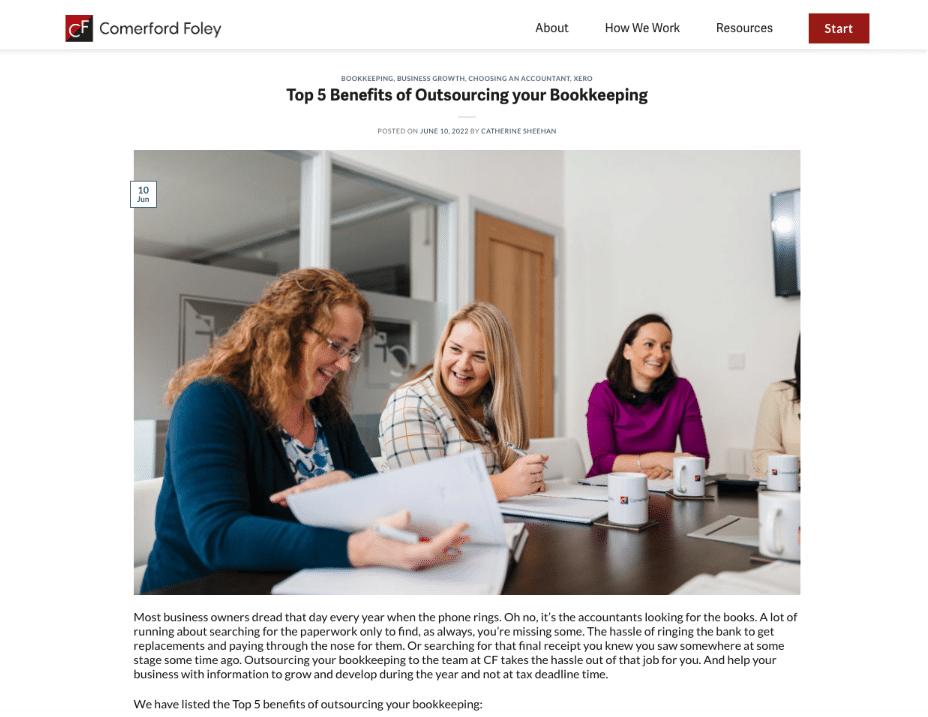
This is a great example of how to create clear, relevant content that helps your prospects and clients. Even from the title, it’s very clear exactly what the reader will gain from the blog. The first paragraph addresses the client’s frustration head-on and the rest of the article goes into great detail about how they can keep this frustration from happening in the future.
When problems do arise, turn the learnings into meaningful, valuable content for your clients and prospects
When frustrating issues arise with prospects and clients, it can be hard to see the positives when you’re in the thick of the situation. Problems can provide some of the greatest learning opportunities which make valuable marketing content (which is then used to prevent those kinds of scenarios in future). Once you’ve solved the problem, and ideally worked on the underlying system to prevent it ever happening again, you can then move to creating content from your learnings. Here’s how you can turn the frustration into content for your audience:
1. Take a note of the problem while it’s fresh in your mind and write it down. This doesn’t have to be an essay; just write down a few key points of what happened. Having it already written up when you go to turn it into a blog, email, PDF guide or social posts will save you recalling what happened from memory alone.
For example Pink Pig Financials were realising that many of their clients were concerned and unsure what steps they could take to effectively manage their business’ cash flow. So they decided to create their own Cashflow Calm Guide to help address this. They have it on their websites for both clients and prospects to use:
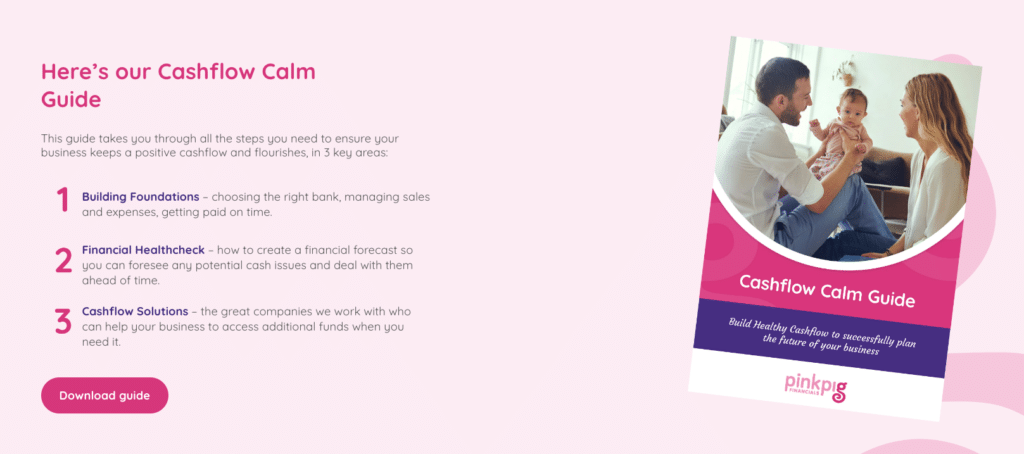
2. Start building out a list of these scenarios and keep it in one place that you can easily locate, like in an Excel document on your computer or in a Google Sheet in a Google Drive folder. This can keep your content ideas from client issues organised and in one place. Here is an example of what that could look like:
Use the rows in the document to help organise your future content:
- Where it falls in the list of content priorities. This will probably be based on how often the issue or question is coming up with your clients
- The topic that it would come under. For example bookkeeping, cashflow, etc.
- The working title of the piece of content. This might change when you go to work on it
- Some notes and key points on what the piece of content could include. This will make it easier to write later on.
- What type of content it will be. For example PDF guide, blog, social post etc.
- Who is going to be responsible for writing it? This could be you, another member of your team or someone else who is helping you with content.
3. Turn your ideas into stackable content. Stackable content is where you generate one piece of content and use it in different areas of your marketing. Take your key points and expand them to turn into a blog or a PDF guide on your website. You can take other smaller sections of the longer content, and turn it into other types of content like social posts. Below is an example of how Fearless Financials took a client frustration and turned it into a blog:
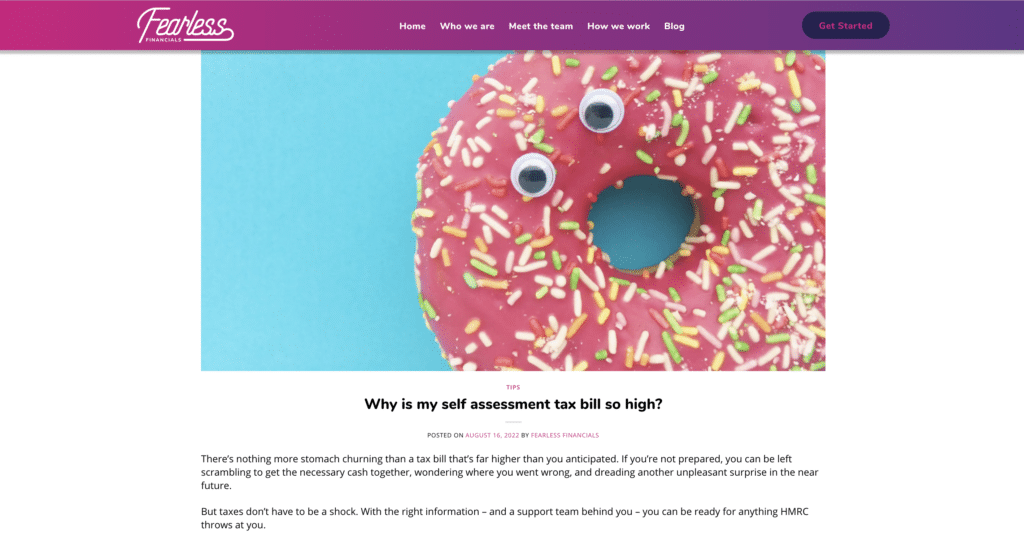
And then into an Instagram post:

Once you have a bank of helpful content, you can start referring people to it. For example, if you’ve written a blog on an issue you had with a client or prospect in the past, you can refer another client directly to the blog if it comes up again and they need more information. Having multiple pieces of valuable content to refer clients to will build trust and credibility.
Having clear expectations will help clear up client frustrations
Thinking like your client and putting yourself in their shoes is a crucial part of understanding the problems your audience is facing. It will be easier for you to serve them, and it’ll help them make quicker buying decisions. Think about this in every asset you put out into the world. From your website to social posts, you need to focus on your audience and the questions and concerns they have.
Clear expectations and a well-defined onboarding process will show them their journey and how the relationship will work. The aim is to make them feel clear, safe, understood and comfortable that you can help put them on the right path. Prospective clients want to know what to expect and what the timing is for the service you’re providing. Your ideal audience might not know anything about the process of working with an accountant, so make sure the information you provide is reflective of that.
Having a niche can help narrow down the problems and make things clearer for the specific group you’re trying to reach; a niche or ideal audience can be based on several different factors. It could be based on a specific industry, personality characteristics or a certain demographic.
Here are 5 ways to set better expectations with prospects and clients:
1. Make it obvious who your audience is and who you’re speaking to. Is the language on your website reflective of the clients you serve and how you serve them? Do you have a pre qualifying system to weed out the clients you don’t want to work with or won’t be able to serve?
Your pre qualifying process could consist of:
- Website content that’s clear about the types of clients you work with, if you have a specific niche
- Showing your values and how you work, so people can qualify themselves out if they’re not a fit
- A contact form or diagnostic with questions that identify your ideal audience
- A discovery call; talking with a potential client can give you an idea of what they’d be like to work with
Here’s a blog with more information on how you can pre qualify leads.
Red Earth makes it very obvious on their website that they only work with Managed Service Providers, and communicate why they’re best placed to serve them.

2. Be very clear on your website about your processes and how you work. This will help clear up any confusion for prospects , helping them decide if you’re a good fit for them. The more you explain your processes in simple, human terms, the better. It will also help people qualify themselves out if your way of working doesn’t resonate with them.
You can communicate this through a “How We Work” page on your website, or through an onboarding graphic like the one from Equibis Accounting:
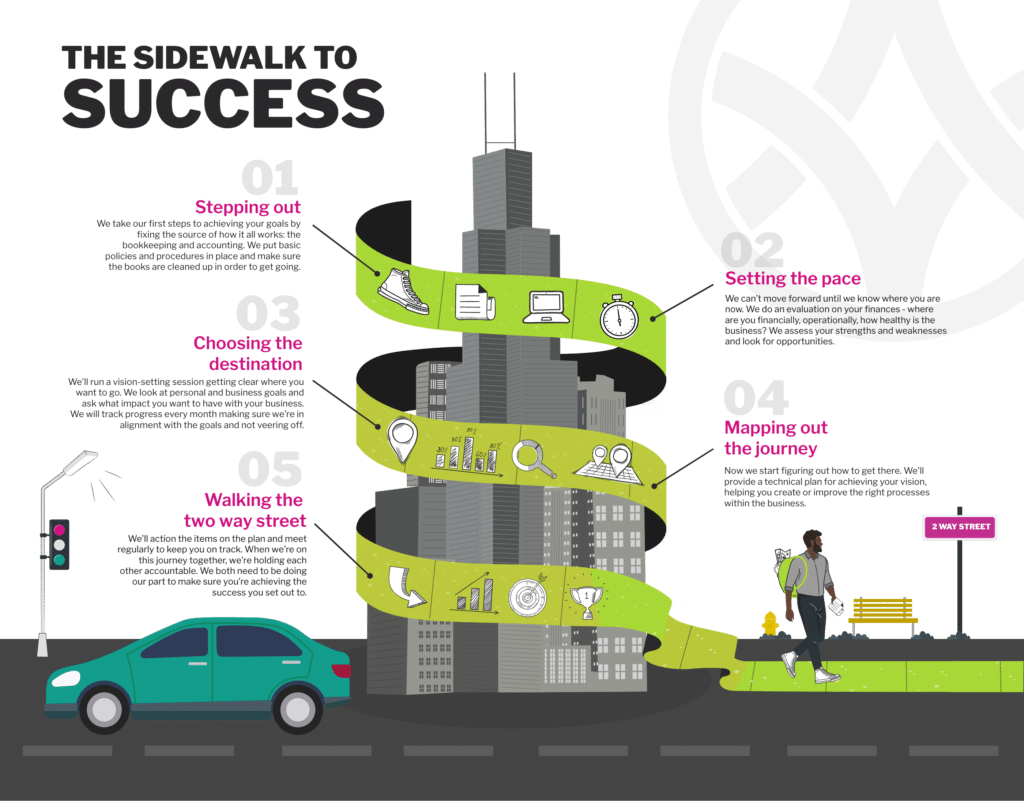
3. Have a clear plan for clients once they get in touch with you, and make it specific to their needs. Document this in a visual way for the client, and go over it with them on a call or in person. This will show you’ve listened to what they need from the very beginning, and you’ve used your experience to come up with a clear solution for them.
Here’s an example of a visual we use to show the PF client journey, recommended for example client Jim:
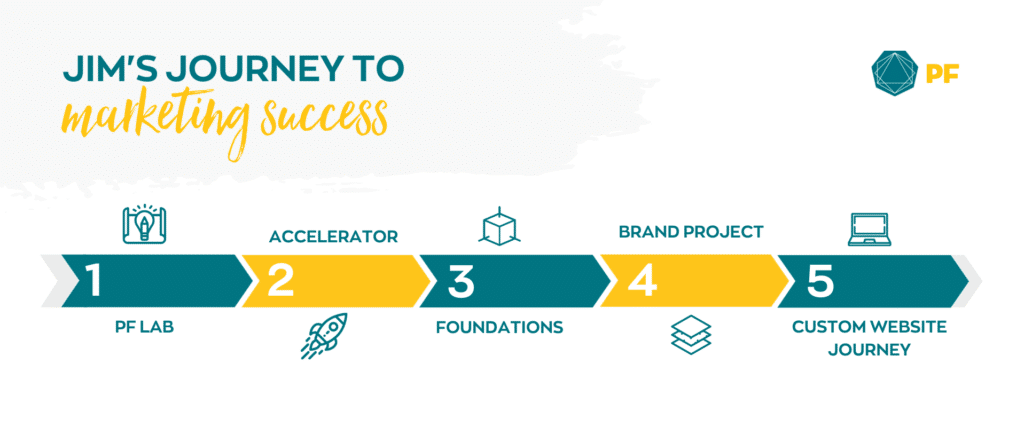
Our design team used Canva to create this graphic. Canva is a free design platform with easy-to-use tools, so you can make your own graphic, or get in touch if you’d like PF’s design team to create one for you.
4. Have regular check-ins with clients to make sure they’re having the best possible experience. This will also help with service reviews and upselling, making sure the client has everything they need based on where they are in their business journey.
Here’s an example of a structure you could use:
- 1 month check in: ensure you have everything you need from them. Are they clear on how the relationship will work? Are they satisfied with the services that will be delivered?
- Quarterly check ins (every 3 months): -Make sure the client is happy with how everything’s working and answer any questions they have.
- 1 year check in: Use this check in as a service review. In this time you’ll have found out what is working for them and what isn’t. This is an opportunity for you to offer more services for them if appropriate, and generally check in to see how things are going.
5. Make sure your team is following synchronised processes and systems. This ensures all clients who are on the same level of service have the same experience, regardless of which team member is responsible for their account.
Strong client relationships built on trust will help you through problems and frustrations
Like with any relationship, open communication, boundaries, and clear expectations are the key to creating a solid foundation with your clients. We’re all human, so while it’s not possible to stop a client frustration from ever happening again, you’ll be able to navigate it in a way that positively impacts your marketing and your client relationships.
Communication that focuses on trust and mutual respect will go a long way with your clients. When you have an issue arise, it’s more likely to have a positive outcome because the client knows you have their best interests at heart. Show your clients you understand and can provide a solution to their frustrations and fears through your communication and content.
Helping our clients build strong relationships with their audience through the power of marketing is what we do. For practical support, observations on your content and an understanding of how you’re really coming across to clients and prospects, our Accelerator coaching group is a great option for you.
